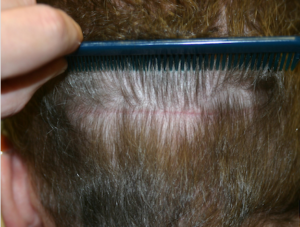Sutures after a hair transplant are easier than you think
A topic that often makes patients a bit nervous when considering a hair transplant procedure is having sutures in the back of their head. But don’t worry; the process is comfortable and I am here to reassure you that it’s simpler than you might think.
After a traditional strip hair transplant, the sutures typically stay in for about 10 to 14 days. This timeframe allows your scalp to start healing properly. You might be thinking, “Ten to Fourteen Days? That sounds like a long time!” But in the grand scheme of things, it’s a relatively short period, especially when you think about the amazing results that are just around the corner.
During the procedure, we remove a strip of skin from the donor area (back of your head) where the hair is healthy and dense. Once that strip is taken out, we need to close the gap. That’s where sutures come in! They help to ensure that the skin heals properly and that the grafts we’ve placed in the balding areas have the best chance to thrive.
Here’s the good news: caring for your sutures is low maintenance! I’ll provide you with detailed aftercare instructions, and I promise you it won’t involve anything too complicated. Here’s what you need to do:
- Keep It Clean: Forty-eight hours after your surgery, you should begin shampooing and conditioning your hair as instructed by our team, both in the morning and at night.
- Avoid Activities: Avoid strenuous exercise like jogging or weightlifting, which can raise your blood pressure. Also, steer clear of bending over so your head is below your waist Trust me, binge-watching your favorite series is a great way to pass the time!
- Use Common Sense: To help prevent infection, try to stay away from dirt and dust—whether you’re at work or having fun—for the first week after your surgery. If you notice any redness, swelling, extra drainage, or a fever, let us know right away.
- Suture Removal: During this visit, we’ll gently remove the sutures from your scalp. This process is usually quick and straightforward, ensuring minimal discomfort. Our team will make sure you’re comfortable and answer any questions you might have about the healing process or next steps.
I know that any medical procedure can feel daunting, but I want to assure you that the suture removal process is quick and straightforward. You might even say it’s one of the easier parts of the journey to your new hair!
Plus, we’re all about making you feel comfortable and informed at every step. If you have any questions or concerns about the stitches or the recovery process, please don’t hesitate to reach out.
Dr. Matthew Lopresti


